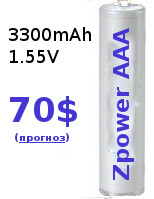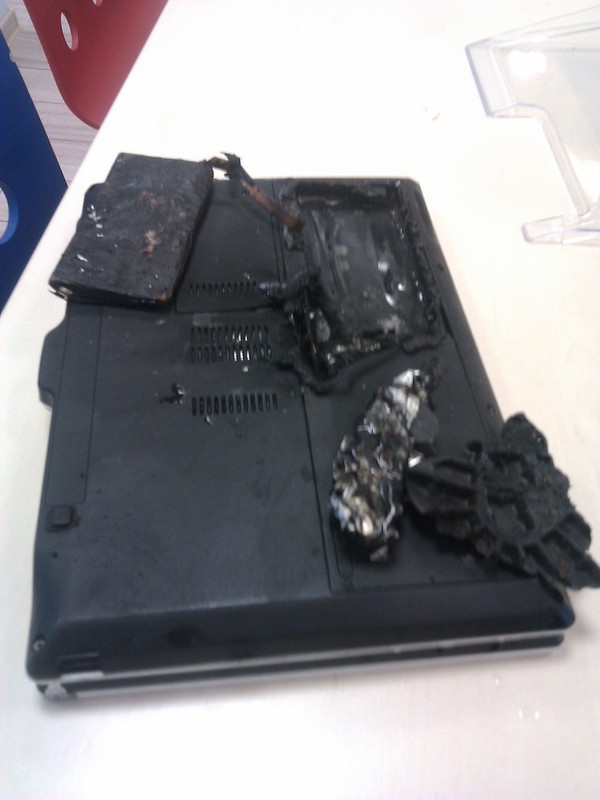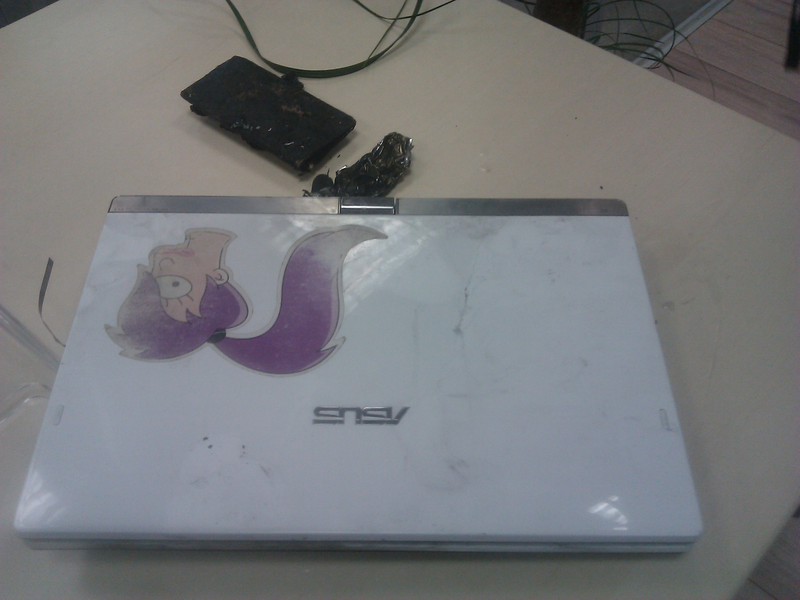Zpower: ultra compact? ultra expensive!
Prologue. Las Vegas 2008:
CSE 2008: Isp. Director of ZPower LLC Ross (Dueber) and the reporter Sparky about the revolution in the battery market :

" Ross : Sparky, we are introducing Silver - Zinc technology for the consumer market. You are now seeing a battery that is better and which will replace lithium-ion in laptops, phones and other portable electronics.
Sparky : So this is something that can replace what is now in a laptop, smartphone, ipod.
Ross : Yes, that's right. We work with their manufacturers in order to have our batteries in the future.
Sparky : Why do they prefer you, and what are the advantages of your technology over lithium-ion?
Ross : We have three main advantages: up to 40% more battery life. (...)
...
Sparky : You said that you work with manufacturers. Can you make replacement batteries? That is, first make a battery for Macbook Pro without agreement with the manufacturer?
Ross : No. All our efforts are now focused on working with manufacturers to develop batteries for new devices, since today's electronics are so heavily sharpened for lithium-ion batteries that you simply cannot use something new on the existing platform.
Sparky : Yes, about these developments: how much effort must be made to achieve compatibility?
Ross : Quite a bit. Here, the first manufacturer with whom we worked: we did most of the work. We got all the necessary those. information and placed in the battery controller, which now interacts with the device. Now the laptop can work on our battery and lithium-ion.
Sparky : What brand are you talking about?
Ross : I can not devote you to these details, but the laptop comes out in the summer of 2008 "..

So, Silver-Zinc
This scheme from the 40s is indispensable in the most high-tech areas. It gives very high power (W / kg, W / l), high specific energy (Wh / kg, Wh / l) and can be carried out on non-magnetic materials. The largest (22,000 Ah, 420 kg) and the smallest (0.17 Ah, 4.5 g) prismatic energy cells in the world are made according to this scheme. Here are some products that use these batteries:
- Batteries for aerospace vehicles, including space shuttles and stations both in the USA and Russia (including Sputnik-1 cm ill.). Batteries of moon rovers, mars rovers and space probes
- The largest rechargeable batteries (256 tons in the USA, 300 tons in Russia) - both for submarines, batteries for bathyscaphes, torpedoes
It is striking that these devices are either from the aerospace or from the defense field, and they have one feature: the performance characteristics here prevail over the economic ones. The price of silver does not allow this technology to step into consumer goods. The only niche on which it has firmly entrenched is microbatches for watches, since the price of such a small battery in the total cost of the product is negligible.
There is another problem: the relative non-rechargeability of such cells caused by the rapid degradation of the electrode. Moreover, even this reversible reaction has a nominal voltage of about 1.2V versus 1.55V of an irreversible reaction, which reduces the energy of such a battery.
Ross Dueber presents 1.55 Volt Rechargeable Technology. Here is the literal translation of one of the press releases.
Taking Silver-Zinc technology to a new level
ZPower uses all the latest advances in polymers, nanotechnology, power electronics and processing methods to create a battery far superior to all existing in performance, safety for us and the environment.
ZPower's success lies in innovation in three elements:
- Composite Zinc Anode
ZPower Zinc Anode Batteries are a composite electrode whose structure prevents dendrite reshaping and growth. In the past, these problems have been a stumbling block in traditional silver-zinc cells. these problems were solved by the new original ZPower technology. - Multi-layer and multifunctional separator
ZPower has created a highly efficient separator that hinders the growth of dendrites on the anode on the one hand, and prevents the degradation of the silver cathode on the other. At the same time, it allows the free movement of ions from the cathode to the anode, minimizing the internal resistance of the cell. As a result of a power cell with a long service life and fast charging. - Nanoparticle Cathode
The silver cathode ZPower consists of coated silver nanoparticles. This nanotechnology provides high conductivity, reducing also the general internal resistance.

Benefits of Silver Zinc technology
- High performance - 40% more energy than lithium-ion and 2-3 times more than Nickel Metal Hydride
- Clean technology - no mercury in the layout, where more than 95% of the elements can be recycled and reused
- Safety - Zinc batteries are thermally stable and safe by themselves.
')
Reality
It all sounds very cool, and the company also boasts of agreements with Apple, Intel, and the US military. In 2012, a patent was confirmed for the entire cell. Well, can you rejoice?
Who else but we, Mugen Power , are interested in such a niche technology, but from the very beginning it was not clear why such a narrow circle of researchers is interested in such a hot topic.
Now we can look at the patents of Zpower itself, make an upper estimate of capacity and energy per gram of battery and compare them with modern lithium-ion cells, as well as modern commercial non-rechargeable Ag-Zn , as with the ceiling of rechargeable technology.

How so!? Where is 40% in energy? She loses Li-ion! Could it be, and why?
To begin with, in spite of the fact that Zpower has been actively stirring up interest in its activities to this day, the claimed advantages have not changed in any way since 2004, while the Li-ion technology has gone a long way.
The prospects for lithium-ion technology were already evident then, and the key advantage at that time, against the background of mass battery recall, was not so much capacity as safety.
The risk in the innovation business does not even lie in what may not turn out, but in what may turn out too late: in these almost 10 years the acuteness of this issue has subsided noticeably, which has spoiled the prospects of Zpower.
Perspectives
From my lines it may seem that everything is lost for this technology, but it is not.

In terms of capacity, such a technology is still ahead of lithium-ion, in power, too. A strong loss in voltage is also an advantage, since it is under 1.5 V that many household appliances are designed. Of course, the cost of such batteries will be high, but feasible, but the charge will not hold longer as Nickel-Metal Hydride.
The company itself hopes to occupy the hearing aid battery market. Many ultracompact hearing aids use non-rechargeable Zinc-air batteries that have similar voltage. Having a rechargeable device for a hearing impaired person is far more important than most of us might think. Imagine: one morning you wake up and do not hear anything, you are an elderly person and you cannot replace the micro battery yourself, and until you insert a new one, you will be tormented by the fear of total hearing loss. Zpower batteries should work for a long time and, importantly, do not heat up when working (without causing discomfort to the auricle).
The military will get significantly improved technology from ZPower.
And finally, for the future: ZPower managed to overcome the problem of dendritic formation of a zinc electrode, which can help create a rechargeable Zinc-Air cell.
Urgently in the room! Zpower strikes back
Do not believe it! Just before my eyes, the ASUS netbook caught fire. Bought two years ago, a regular battery


it's only the beginning
Source: https://habr.com/ru/post/173431/
All Articles